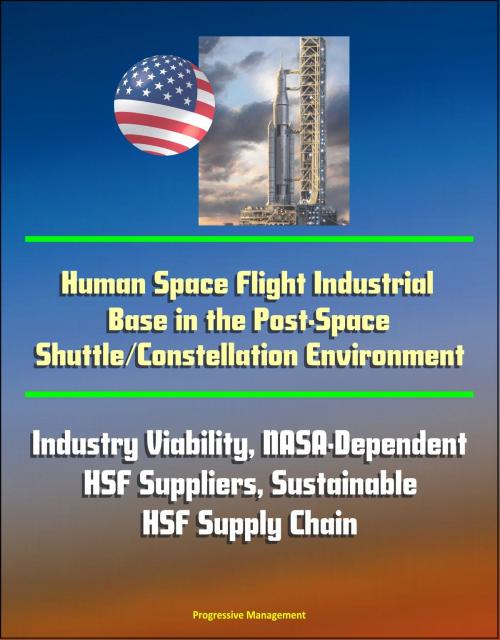Human Space Flight Industrial Base in the Post-Space Shuttle/Constellation Environment: Industry Viability, NASA-Dependent HSF Suppliers, Sustainable HSF Supply Chain
Nonfiction, Science & Nature, Technology, Aeronautics & Astronautics, Science, Physics, Astrophysics & Space Science| Author: | Progressive Management | ISBN: | 9781311305626 |
| Publisher: | Progressive Management | Publication: | September 6, 2014 |
| Imprint: | Smashwords Edition | Language: | English |
| Author: | Progressive Management |
| ISBN: | 9781311305626 |
| Publisher: | Progressive Management |
| Publication: | September 6, 2014 |
| Imprint: | Smashwords Edition |
| Language: | English |
The National Aeronautics and Space Administration's (NASA) Exploration Systems Mission Directorate and the Bureau of Industry and Security's (BIS) Office of Technology Evaluation (OTE) initiated an industrial base assessment of NASA's human space flight supply chain, specifically suppliers participating in the Space Shuttle Program (Shuttle), the Shuttle's follow-up program Constellation (CxP), and the International Space Station (ISS). NASA had concerns about the industrial base impacts resulting from the retirement of the Shuttle and the transition from CxP, and sought current, in-depth, multi-tier supplier information from BIS that would help NASA prioritize its funding allocations and program planning during the anticipated procurement gap.
This final report will benefit NASA and other USG agencies that are involved in space activities, as well as the corresponding U.S. space industrial base community. With four years of complete data and a five-year sales projection, industry and government officials can use this report as a benchmark to better monitor trends and supplier performance in the HSF supply chain. This previously unavailable data highlights current and potential diminishing U.S. space-related manufacturing capabilities, technologies, and labor skills that can be used by decision makers to plan future actions to maintain and enhance the HSF supply chain.
Due to a projected five-or-more year gap between the end of Shuttle and full production of CxP, NASA's Exploration Systems Mission Directorate approached the Bureau of Industry and Security's (BIS) Office of Technology Evaluation (OTE) in late 2009 to conduct an assessment on the ability of NASA's Shuttle-related human space flight (HSF) supply chain to maintain critical capabilities during the gap period. Unexpectedly, NASA was directed in early 2010 to "transition" from CxP to deep-space exploration (bypassing the Moon), and CxP-related funding was reduced to a few core components for deep-space projects, while funding for ISS was extended through 2020. The OTE assessment was therefore modified to include these changing factors.
NASA and OTE designed a survey to gather in-depth information on all parts of NASA's human space flight (HSF) supply chain and its ability to operate during the anticipated procurement gap, now between Shuttle/CxP and future deep-space exploration. OTE collected information covering 2007-2010 from 536 companies identified by NASA as Shuttle, CxP, and ISS program suppliers.
The Shuttle retirement and CxP transition will impact future NASA HSF programs through a loss of unique skills, capabilities, products, and services by select suppliers. The assessment highlights and prioritizes immediate areas of concern for NASA, with focus on the 150 survey respondents that identified themselves as dependent on NASA. Within the group of 150 NASA-dependent companies, the 46 NASA-dependent companies that reported negative net profit margins for at least one year from 2007-2010 should be given particular attention. Without continued business opportunities, these companies have the highest potential of shutting down. Ongoing efforts to develop a deep-space exploration capsule and heavy-lift rocket capability are important first steps to maintaining capabilities, and should be viewed as the building blocks to spur a sustainable HSF supply chain.
The assessment also reveals many areas of opportunity for future NASA action, including: increasing communication and outreach with the HSF supply chain; coordinating efforts with regional, state, local, educational, and non-profit organizations and institutions; working with other U.S. Government agencies to address interdependency issues, find commonalities, and leverage mutual interests to support the industrial base; and directing more Federal Government research and development funds to smaller companies as well as diversifying the number of companies conducting NASA-related research and development.
The National Aeronautics and Space Administration's (NASA) Exploration Systems Mission Directorate and the Bureau of Industry and Security's (BIS) Office of Technology Evaluation (OTE) initiated an industrial base assessment of NASA's human space flight supply chain, specifically suppliers participating in the Space Shuttle Program (Shuttle), the Shuttle's follow-up program Constellation (CxP), and the International Space Station (ISS). NASA had concerns about the industrial base impacts resulting from the retirement of the Shuttle and the transition from CxP, and sought current, in-depth, multi-tier supplier information from BIS that would help NASA prioritize its funding allocations and program planning during the anticipated procurement gap.
This final report will benefit NASA and other USG agencies that are involved in space activities, as well as the corresponding U.S. space industrial base community. With four years of complete data and a five-year sales projection, industry and government officials can use this report as a benchmark to better monitor trends and supplier performance in the HSF supply chain. This previously unavailable data highlights current and potential diminishing U.S. space-related manufacturing capabilities, technologies, and labor skills that can be used by decision makers to plan future actions to maintain and enhance the HSF supply chain.
Due to a projected five-or-more year gap between the end of Shuttle and full production of CxP, NASA's Exploration Systems Mission Directorate approached the Bureau of Industry and Security's (BIS) Office of Technology Evaluation (OTE) in late 2009 to conduct an assessment on the ability of NASA's Shuttle-related human space flight (HSF) supply chain to maintain critical capabilities during the gap period. Unexpectedly, NASA was directed in early 2010 to "transition" from CxP to deep-space exploration (bypassing the Moon), and CxP-related funding was reduced to a few core components for deep-space projects, while funding for ISS was extended through 2020. The OTE assessment was therefore modified to include these changing factors.
NASA and OTE designed a survey to gather in-depth information on all parts of NASA's human space flight (HSF) supply chain and its ability to operate during the anticipated procurement gap, now between Shuttle/CxP and future deep-space exploration. OTE collected information covering 2007-2010 from 536 companies identified by NASA as Shuttle, CxP, and ISS program suppliers.
The Shuttle retirement and CxP transition will impact future NASA HSF programs through a loss of unique skills, capabilities, products, and services by select suppliers. The assessment highlights and prioritizes immediate areas of concern for NASA, with focus on the 150 survey respondents that identified themselves as dependent on NASA. Within the group of 150 NASA-dependent companies, the 46 NASA-dependent companies that reported negative net profit margins for at least one year from 2007-2010 should be given particular attention. Without continued business opportunities, these companies have the highest potential of shutting down. Ongoing efforts to develop a deep-space exploration capsule and heavy-lift rocket capability are important first steps to maintaining capabilities, and should be viewed as the building blocks to spur a sustainable HSF supply chain.
The assessment also reveals many areas of opportunity for future NASA action, including: increasing communication and outreach with the HSF supply chain; coordinating efforts with regional, state, local, educational, and non-profit organizations and institutions; working with other U.S. Government agencies to address interdependency issues, find commonalities, and leverage mutual interests to support the industrial base; and directing more Federal Government research and development funds to smaller companies as well as diversifying the number of companies conducting NASA-related research and development.















